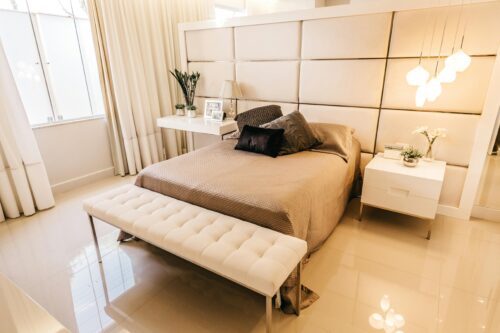Use Nightstands to Add Storage and Style to a Bedroom
Generally, the nightstand is thought of only for night use. It’s one of those pieces of furniture we don’t think about very much but use and rely on all the time. Our nightstands are always there for us. And regardless of its stated function, it can be attractive, too.
Today, the bedroom has taken on a different look. TV units are often built in the bedroom opposite the bed, hung on the wall, or at the foot of the bed in a cabinet with a hydraulic lift rather than having the traditional dresser or highboy. Therefore, we have less storage in the bedrooms for our clothing. Instead, we have built-in cabinets in our closets for our clothes; often, however, there isn’t room for all our clothing in one area. This is when I recommend using the space between the bed and the side walls, which can accommodate a wider nightstand for extra clothing. The nightstand actually doubles as a small dresser, which also gives you more surface space. This is a good use of space because as a rule nothing else will fit between the night table and the wall. Your room will appear larger also. This will probably require that you have it built so that it fits the space perfectly.
Feel free to have two dissimilar night tables—particularly if two people are using the same bed; each person has different needs and tastes. This can be defined by two completely different night tables—such as mixing a rectangle with a curve. Night tables don’t have to match anything else in the room either. Regardless, of whether your style of furniture is traditional or contemporary, it can be more interesting to use unusual looking night tables.
The height of the night tables can be more personalized, too. The height may vary depending on the height of the mattress which has been on the rise. No pun intended! There are people who like to reach up from their bed, while others would rather reach down. Each person is different. Generally, the height of the table should be as level with the bed as possible for ease of reaching and viewing, such as a lamp or an alarm clock. Since the nightstand is longer it could be more than one height.
Be sure the lamp isn’t so high that you see it totally under the shade and right into the light bulb. However, it does need to be placed properly for reading in bed. If recess or track lights are installed in the ceiling right over the pillows (or sconces to the side of the bed on the wall) you can eliminate the lamps and gain even more space. Happily, your nightstand is a personal place of management if you keep it neat, organized, and beautiful. But beware, it often can be a source of clutter, too.
Some people have so much stuff on their nightstands that they need a pull-out drawer for a glass of water. I have seen nightstands piled high with books, newspapers, magazines, and miscellaneous papers from work or hobbies. If you have concerns that the surface could be damaged, you could put a 1/8” to ¼” piece of glass that fits exactly to the edge to protect a delicate surface.
Consider putting things on your nightstands that you like looking at and that make you feel good. These are the last things you see at night when you get to bed and the first things you see when you get out of bed. Make sure whatever you use is welcoming to you.
YOUR nightstand is there to provide comfort and peace of mind, so design it to support you. Remember, rooms have no feelings, YOU do!
Barbara Kaplan, Allied ASID, IFDA, Personal Interior Design & Lifestyle Consultant & Color Analyst
STROLL MAGAZINE
